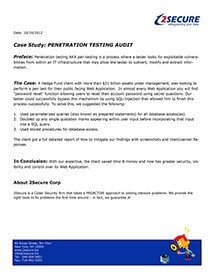Penetration Testing Services Company
Identify Your Vulnerabilities Before Hackers Do!
Penetration testing AKA pen-testing or pen test is a process where a tester looks for exploitable vulnerabilities from within an IT infrastructure that may allow the tester to subvert, modify, and extract information.
Why Should You Invest In Penetration Testing Services
Small businesses are often targeted by cybercriminals due to limited resources for cybersecurity. Highlight how your services address their unique challenges:
Risk Mitigation:
Penetration testing identifies weaknesses that attackers could exploit, enabling businesses to strengthen their defenses and avoid costly breaches.Regulatory Compliance:
Meeting industry standards like PCI-DSS, HIPAA, or GDPR is crucial for SMBs to avoid penalties and build trust with clients.Cost Savings:
Preventing a cyberattack is far less expensive than recovering from one. Our services offer a cost-effective way to protect sensitive data and avoid downtime.
Our Penetration Testing Services

Network Penetration Testing
This service identifies vulnerabilities in both internal and external networks. Our experts simulate attacks to uncover security gaps, such as misconfigured firewalls, open ports, or weak encryption protocols. We provide actionable recommendations to secure your network infrastructure.

Social Engineering Assessments
Human error is often the weakest link in cybersecurity. We test your organization’s resilience to phishing, baiting, and other social engineering tactics, offering training and recommendations to fortify your workforce against manipulation.

Web Application Penetration Testing
Focused on the security of web applications, we test for vulnerabilities like SQL injection, cross-site scripting (XSS), and insecure authentication mechanisms. This service ensures your web applications are robust against attacks.
Essential Steps For A Successful Penetration Testing
Penetration tests are typically performed using manual and automated technologies to systematically compromise servers, endpoints, web applications, wireless networks, network devices, mobile devices, and other potential points of exposure.
The process typically includes the following steps.
This information is then used to design a more effective security strategy, prioritize remediation, apply targeted patches, and improve overall security awareness.
DELIVERIES
- Managers summary
- Technical summary accompanied by a detailed report with all potential holes and how to mitigate them
- Redesign a secure infrastructure that is efficient and cost-effective in order to reduce the cost of ownership

